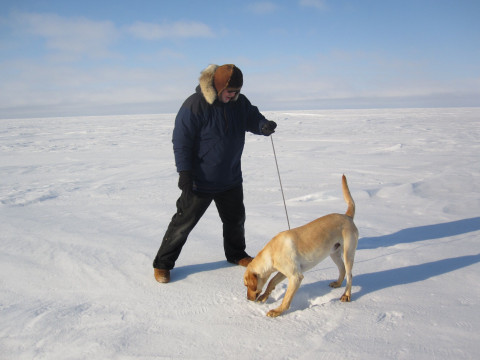The Saimaa ringed seal is not the only seal species suffering from global warming, as the habitat of seals living in the Arctic is shrinking as we speak, said Brendan P. Kelly, a marine ecologist focusing on sea ice environments, in his lecture on Arctic seal research.
Dr Kelly holds the positions of Science Director of the Study of Environmental Arctic Change, Professor of Marine Biology at the University of Alaska Fairbanks, and Senior Fellow in Middlebury Institute of International Studies at Monterey.
For thirty years already, Dr Kelly has spent a couple of months a year in the Arctic, living on ice and studying the life of seals. During this time, our understanding of different seal species has increased gradually, although it has been difficult to carry out a comprehensive census of the seal population. What we do know is that Arctic ringed seals number in millions – at least for now.
“Seals have existed for millions of years. They’ve made a bold evolutionary move, as leaving the water has meant being vulnerable to predators,” Dr Kelly notes.
And it is not just predators that threaten seals: humans and climate change do, too, as seal habitats are rapidly shrinking due to melting sea ice and snow. Animal extinction is nothing new under the sun, but the speed at which things are happening now is overwhelming.
“Greenhouse gases are increasing and causing our climate to warm. In the Arctic, warming takes place more than twice as fast as the global average. The ice cover is like a huge mirror that reflects sunlight back into space, and once that’s gone, the dark ocean water warms faster and faster,” Dr Kelly says.
Half the Arctic ice cover has already disappeared.
Brendan P. Kelly
Principal Investigator and Science Director, University of Alaska Fairbanks
Artificial lairs pose a challenge in the Arctic
Dr Kelly and his research group have conducted extensive research into the movement and behaviour of seals. The aim is to find better conservation methods.
“Seals spend 80% of their time in the water. They can breathe under snow and in the snow caves they dig,” Dr Kelly says.
The fur of a seal pup provides little insulation from cold. The mother warms up the lair—insulated by snow – as she comes in to feed her pup, but if the snow cover is too thin, the pups face predation and freezing if exposed on bare ice.
“In the Arctic, however, making artificial lairs is difficult due to the vast areas of ice habitat.”
In the breeding season, female seals typically dive down to more than 100 metres in search of food, while males make shallower dives in the vicinity of the females’ breathing holes.
Satellite monitoring of seals shows that a male seal can swim a distance of 2,500 kilometres and then return to its exact home habitat.
“Seals have a better signal on their GPS than us scientists,” Dr Kelly notes.
For Inuit, seals are part of a thousand-year-old culture
According to Dr Kelly, seal conservation is not a straightforward question for Inuit people, because seals are an important part of their nutrition and culture.
“Inuit people are worried about conservation areas blocking their access to seals on ice, for example. However, we have managed to find some good and new ways of working together.”
The Inuit have been hunting seals for thousands of years using dogs, for example, so they have huge amounts of knowledge about how seals live.
“This knowledge should be made more easily accessible to decision-makers and politicians in order for conservation measures to consider all sides,” Dr Kelly says.
“We academics have a terrible habit of burying information: we should be better at communicating our knowledge in plain language and in stories. On that front, we still have a lot of work to do.”

